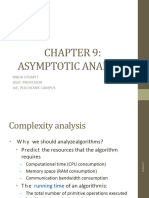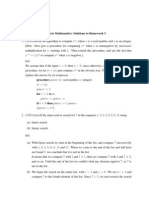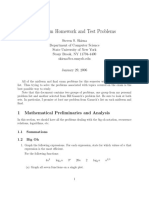0% found this document useful (0 votes)
34 views50 pagesLecture 09 Algo
This document discusses algorithms and algorithmic complexity. It begins by defining an algorithm as a finite set of precise instructions for performing a computation or solving a problem. It then provides examples of pseudo-code for algorithms, including ones for finding the minimum value in an array and checking if a function is surjective. It analyzes the time complexity of these algorithms by counting the number of basic operations. It finds that the second algorithm for checking surjectivity runs in O(n+m) time while the first runs in O(mn) time, making the second more efficient. Finally, it discusses some issues with analyzing time complexity and introduces formal definitions of big-O notation.
Uploaded by
Saif Mahmood Chowdhury 2132325642Copyright
© © All Rights Reserved
We take content rights seriously. If you suspect this is your content, claim it here.
Available Formats
Download as PDF, TXT or read online on Scribd
0% found this document useful (0 votes)
34 views50 pagesLecture 09 Algo
This document discusses algorithms and algorithmic complexity. It begins by defining an algorithm as a finite set of precise instructions for performing a computation or solving a problem. It then provides examples of pseudo-code for algorithms, including ones for finding the minimum value in an array and checking if a function is surjective. It analyzes the time complexity of these algorithms by counting the number of basic operations. It finds that the second algorithm for checking surjectivity runs in O(n+m) time while the first runs in O(mn) time, making the second more efficient. Finally, it discusses some issues with analyzing time complexity and introduces formal definitions of big-O notation.
Uploaded by
Saif Mahmood Chowdhury 2132325642Copyright
© © All Rights Reserved
We take content rights seriously. If you suspect this is your content, claim it here.
Available Formats
Download as PDF, TXT or read online on Scribd
/ 50





























































































